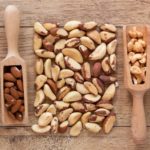
Craig Ballard
(MSc (Sports & Exercise Nutrition), BSc, BTEC (Sports & Exercise Sciences), CYQ/QCF (Personal training and Instruction))
Jump to:
The ketogenic diet (KD), characterised by high-fat, moderate protein, and very low-carbohydrate intake, has gained popularity among athletes for its potential benefits on body composition, more specifically fat loss, and performance. However, its impact on physical performance remains a topic of debate within the scientific community.
RELATED — Introduction to: The Ketogenic Diet (Part 1)
There is a lot of anecdotal evidence to suggest that a KD may in fact be optimal at enhancing performance metrics when it comes to physical activity and physique development, although the research to date seems to be somewhat conclusive that this is not the case.
But, are there certain scenarios or individual circumstances where a KD may be more beneficial over other dietary approaches?
Physique Development
The combination of a KD within multiple resistance training interventions showed that the diet enhances the rate of fat mass loss, which may be advantageous for those wanting to improve their power-to-weight ratio.
Though compared to non-KD approaches, it may not be a suitable dietary strategy for increasing muscle mass. This is presumably due to the participant’s inability to reach the required energy (calorie) surplus to maximise lean tissue gain.[1,2,3,4]
Similar results were showcased again in strength trained women versus a control group. Subjects on a KD lost more fat, but gained less lean mass during a resistance training programme.
Additionally, participants on the KD tended to consume fewer calories compared to the control group. The control group, on a non-ketogenic diet, also displayed better strength gains in comparison.[5]
There have also been instances where a KD has proven to be less effective for reducing fat mass, still appearing to be less optimal for increasing skeletal muscle mass and strength gains during a training intervention in healthy young males.[6]
Regarding strength performance, particularly in 1 repetition maximum (1RM) lifts, a recent meta-analysis showed a more favourable effect size for non-KD approaches. While a KD didn’t necessarily have a negative impact on 1RM strength, it was outperformed by higher carbohydrate diets.[4]
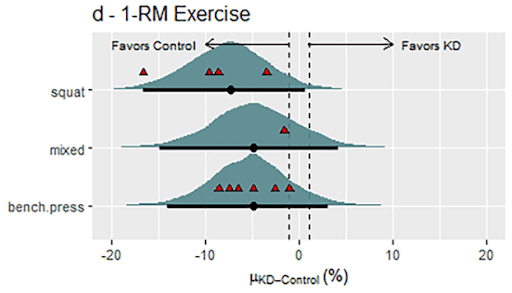
That being said, the current evidence base does show that KDs can be an effective alternative to traditional dietary macronutrient splits in specific cases:
- Individuals primarily focused on fat loss
- Individuals following a low-volume resistance training programme and/or engaging in low-intensity exercise
- Individuals not prioritising lean mass gain or high-intensity performance
In other scenarios involving moderate-to-high volume resistance training, prioritising moderate-to-high-intensity exercise, or aiming to gain lean mass, KDs may not be the optimal choice.[4]
This does not imply that gains are impossible on a KD or that its effects on resistance training are detrimental; rather, it suggests that those looking to optimise such adaptations should consider a more traditional macronutrient split that includes sufficient carbohydrate intake.
A ketogenic diet is not the best option for high-intensity exercise performance
A well-constructed KD can be a viable option during a fat loss phase, but ketogenic diets do not seem to be the best option for lifters or athletes who are primarily focused on hypertrophy or high-intensity exercise performance.
Endurance Performance
If we want to run as fast as possible over distances from 800 metres to a marathon (42 km), we will need carbohydrates to fuel our activity.
Although our adipose tissue has somewhat unlimited energy reserves, the rate of ATP (energy) synthesis from lipid (fat) metabolism is too slow to meet the ATP demands of contracting muscles during these events, especially at the pace of elite athletes.[7]
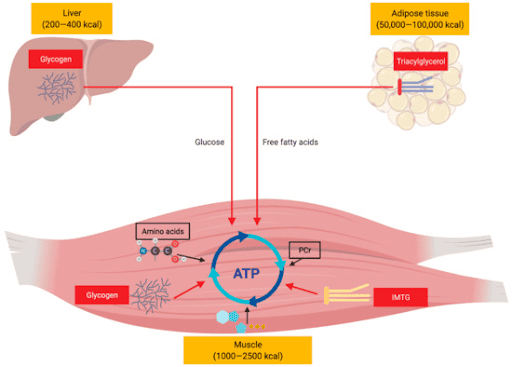
While our immediate energy system, the phosphocreatine system, can supply ATP quickly (for a duration of 10-12 seconds), its capacity is limited, making carbohydrates the primary fuel source for these running distances. In this scenario we would utilise both our glycolytic and aerobic energy systems for the majority of our energy production.
Training intensity for endurance exercise is measured by VO2 max, the maximum oxygen usage rate during exercise. At intensities around 85% VO2 max, energy comes almost exclusively from carbohydrates. This is assessed using the respiratory exchange ratio (RER), which measures the ratio of carbon dioxide produced to oxygen consumed.[8]
This reliance on carbohydrates over different exercise intensities has been well-documented since the early 1990s, as displayed in the graph below.[9]
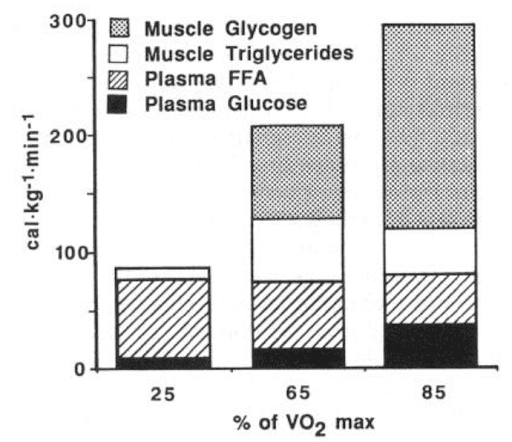
Early studies exploring low glycogen training or high-fat diets aimed to increase free fatty acid (FFA) oxidation during exercise and conserve muscle glycogen to delay fatigue. However, while these approaches do enhance the ability to oxidise FFA, they also result in a decreased capacity to oxidise carbohydrates.[9,10,11]
A recent meta-analysis examined the effects of KDs on body composition and performance outcomes compared to alternative diets in trained subjects aged 18-60. The KDs consisted of 60-80% of calories from fat, with less than 10% of calories or under 50g of carbs per day. The non-ketogenic diets included at least 40% of calories from carbs.[4]
Ketogenic diets usually have less than 50g of carbohydrates per day
The results indicated that KDs were less favourable than control diets for cycling performance, strength performance, and increases in fat-free mass. However, KDs were more favourable for reducing body mass and fat mass.[4]
These outcomes are mirrored in previous studies. That being said, KDs do seem to be beneficial for endurance performance by augmenting fat oxidation capacity, particularly in long-distance events lasting from 2 to 5 hours.[12,13,14,15]
A KD may be beneficial or provide no decrease in low-intensity exercise performance, but likely reduces performance in activities above 70% VO2 max.
While KDs enhance fat oxidation, they can impair high-intensity performance due to downregulation of pyruvate dehydrogenase activity, leading to decreased oxygen efficiency.[16,17]
How the Ketogenic Diet May Benefit Athletes
Individual responses to performance enhancements on a KD can differ greatly. Here are potential ways the KD may benefit athletes.
Enhanced fat oxidation
Reduced dependence on glycogen
Reduction in fat mass and/or fat-free mass
Individuals that wish to reduce body weight for competitive events or to make weight classes may find a KD helpful in the short term without a detriment to performance.[22]

How to apply a ketogenic/low-carbohydrate diet for optimal performance
Although the KD can offer certain benefits, it can directly impact skeletal muscle glycogen content, potentially impacting exercise capacity.
Low-carbohydrate diets have been shown to inhibit the muscle protein synthesis (MPS) response to exercise via mTOR pathways in elite athletes.[23] This could be a likely theoretical reason as to why KDs are found to have worse outcomes for increasing lean mass in resistance trained individuals.
However, athletes might benefit from strategically planned periods of reduced carbohydrate availability before and during exercise to enhance mitochondrial related cell signalling, said to potentially increase work efficiency. But you should consume both carbohydrates and protein post-exercise to restore the activation of MPS related signalling.[23]
RELATED — Diet and Performance: High-Carb or Ketogenic Diet?
Ketogenic or very low-carbohydrate diets can be utilised in conjunction with high carbohydrate diet approaches to unlock the adaptations you might gain from both regiments. This is called carbohydrate periodization. Carbohydrate periodization is the manipulation of carbohydrate availability on a day-to-day or even a meal-to-meal basis.[24,25]
This was popularised by Team Sky and their cycling team with their successful UCI World Tour, with 5 Tour de France winners over a 6-year period.
Adaptation Period and Performance Improvements
While transitioning to a ketogenic state only takes 2-7 days, fully adjusting to a KD typically takes 2-3 weeks, though it may take longer for some individuals.
During the adjustment phase to the KD, commonly known as “keto adaptation,” it is common to experience fatigue and energy deficiency during the first few weeks along with other symptoms, such as headaches and nausea. It’s important to note that the initial decrease in performance during this adaptation period is temporary.[25]
Based on consumer reports, one study has depicted the time course in which users reported symptoms below.
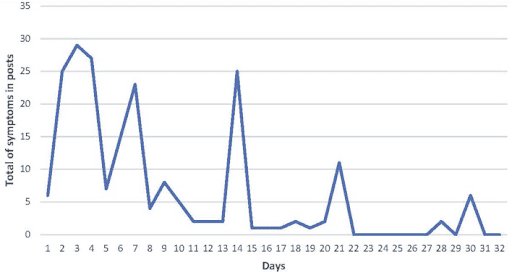
Once the body is fully adapted to ketosis, some individuals may experience benefits, particularly in activities that rely on fat metabolism. However, high-intensity, short-duration activities will still be impacted.[17,21]
It is interesting to note that some evidence suggests that the longer the KD intervention, the lesser the performance differences between the KD and control diet approaches, shown in interventions up to 12 weeks. However, in this meta-analysis, performance adaptation was still more favourable to control diets compared to KD.[4]
KD offers a practical dietary strategy for enhancing body composition in endurance trained athletes by reducing both body mass and fat mass, likely while preserving fat-free mass.
Current evidence suggests that the fat-free mass preserving effects of KD are more pronounced in endurance trained individuals compared to those engaged in resistance training. This is attributed to a shift in fuel utilisation toward increased fat oxidation during exercise.[17,18,21]
There is some evidence to suggest that women may have a better response to KDs in regards to endurance performance outcomes due to their greater potential for oxidising more fat than men at similar exercise intensities.
This paired with a larger percentage of type-one muscle fibres being ‘slow twitch’, have less reliance on carbohydrates, though performance outcomes still trend towards higher carbohydrate diets.[4]
There is considerable interest in ketone supplementation to explore whether the potential effects of a KD can be replicated with exogenous ketones.
However, current data suggests that this is not the case. While there is potential for improving sports performance when already utilising a KD, further research is required to fully comprehend the impact of ketone supplementation when aligned with a KD.[19,26]
Conclusion
The reputation of ketogenic diets in the evidence-based fitness community may be more negative than the data supports.
Some studies suggest ketogenic diets can aid in weight loss and body composition, but their effects on physical performance, especially in high-intensity or endurance activities, are mixed.
A low-carbohydrate state can reduce exercise capacity, potentially affecting long-term training and competition goals. To mitigate this, low-load sessions can be done with lower carbohydrate availability, while high-intensity sessions should be fuelled with higher carbs.
Early research on low glycogen training and high-fat diets aimed to enhance fatty acid oxidation and conserve muscle glycogen, but this can also reduce carbohydrate oxidation capacity.
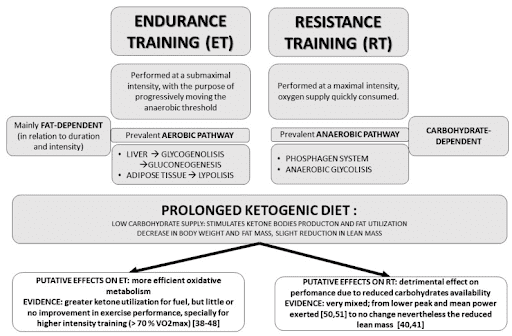
For hypertrophy or performance in glycolytic tasks, a non-ketogenic diet may be slightly more effective. However, if you prefer a ketogenic diet and its food options, it can still be beneficial, particularly for fat loss.
That being said, a combination of high and low-carbohydrate approaches is optimal for high-performance athletes.
References
(1) Vargas S, Romance R, Petro JL, Bonilla DA, Galancho I, Espinar S, Kreider RB, Benítez-Porres J. Efficacy of ketogenic diet on body composition during resistance training in trained men: a randomized controlled trial. J Int Soc Sports Nutr. 2018 Jul 9;15(1):31. doi: 10.1186/s12970-018-0236-9. PMID: 29986720; PMCID: PMC6038311. https://www.ncbi.nlm.nih.gov/pmc/articles/PMC6038311/
(2) Vargas-Molina, S., Gómez-Urquiza, J. L., García-Romero, J., & Benítez-Porres, J. (2022). Effects of the ketogenic diet on muscle hypertrophy in resistance-trained men and women: A systematic review and meta-analysis. International Journal of Environmental Research and Public Health, 19(19), 12629. https://doi.org/10.3390/ijerph191912629
(3) Paoli, A., Cenci, L., Pompei, P., Sahin, N., Bianco, A., Neri, M., Caprio, M., & Moro, T. (2021). Effects of Two Months of Very Low Carbohydrate Ketogenic Diet on Body Composition, Muscle Strength, Muscle Area, and Blood Parameters in Competitive Natural BodyBuilders. Nutrients, 13(2), 374. https://doi.org/10.3390/nu13020374
(4) Koerich, A. C. C., Borszcz, F. K., Thives Mello, A., de Lucas, R. D., & Hansen, F. (2023). Effects of the ketogenic diet on performance and body composition in athletes and trained adults: a systematic review and Bayesian multivariate multilevel meta-analysis and meta-regression. Critical reviews in food science and nutrition, 63(32), 11399–11424.
(5) Vargas-Molina, S., Petro, J. L., Romance, R., Kreider, R. B., Schoenfeld, B. J., Bonilla, D. A., & Benítez-Porres, J. (2020). Effects of a ketogenic diet on body composition and strength in trained women. Journal of the International Society of Sports Nutrition, 17(1), 19. https://doi.org/10.1186/s12970-020-00348-7
(6) Kysel, P., Haluzíková, D., Doležalová, R. P., Laňková, I., Lacinová, Z., Kasperová, B. J., Trnovská, J., Hrádková, V., Mráz, M., Vilikus, Z., & Haluzík, M. (2020). The Influence of Cyclical Ketogenic Reduction Diet vs. Nutritionally Balanced Reduction Diet on Body Composition, Strength, and Endurance Performance in Healthy Young Males: A Randomized Controlled Trial. Nutrients, 12(9), 2832. https://doi.org/10.3390/nu12092832
(7) Alghannam, A. F., Ghaith, M. M., & Alhussain, M. H. (2021). Regulation of Energy Substrate Metabolism in Endurance Exercise. International journal of environmental research and public health, 18(9), 4963. https://doi.org/10.3390/ijerph18094963
(8) Romijn, J. A., Coyle, E. F., Sidossis, L. S., Gastaldelli, A., Horowitz, J. F., Endert, E., & Wolfe, R. R. (1993). Regulation of endogenous fat and carbohydrate metabolism in relation to exercise intensity and duration. The American journal of physiology, 265(3 Pt 1), E380–E391.
(9) Wagner P. D. (1996). Determinants of maximal oxygen transport and utilization. Annual review of physiology, 58, 21–50.
(10) Bellar, D., & Judge, L. W. (2012). Modeling and relationship of respiratory exchange ratio to athletic performance. Journal of strength and conditioning research, 26(9), 2484–2489. https://doi.org/10.1519/JSC.0b013e31823f271d
(11) Goedecke, J. H., Christie, C., Wilson, G., Dennis, S. C., Noakes, T. D., Hopkins, W. G., & Lambert, E. V. (1999). Metabolic adaptations to a high-fat diet in endurance cyclists. Metabolism: clinical and experimental, 48(12), 1509–1517.
(12) Stellingwerff, T., Spriet, L. L., Watt, M. J., Kimber, N. E., Hargreaves, M., Hawley, J. A., & Burke, L. M. (2006). Decreased PDH activation and glycogenolysis during exercise following fat adaptation with carbohydrate restoration. American journal of physiology. Endocrinology and metabolism, 290(2), E380–E388. https://doi.org/10.1152/ajpendo.00268.2005
(13) Ashtary-Larky, D., Bagheri, R., Bavi, H., Baker, J. S., Moro, T., Mancin, L., & Paoli, A. (2022). Ketogenic diets, physical activity and body composition: a review. The British journal of nutrition, 127(12), 1898–1920. https://doi.org/10.1017/S0007114521002609
(14) Roekenes, J., & Martins, C. (2021). Ketogenic diets and appetite regulation. Current opinion in clinical nutrition and metabolic care, 24(4), 359–363. https://doi.org/10.1097/MCO.0000000000000760
(15) Paoli A. (2014). Ketogenic diet for obesity: friend or foe?. International journal of environmental research and public health, 11(2), 2092–2107. https://doi.org/10.3390/ijerph110202092
(16) Tiller, N. B., Roberts, J. D., Beasley, L., Chapman, S., Pinto, J. M., Smith, L., Wiffin, M., Russell, M., Sparks, S. A., Duckworth, L., O’Hara, J., Sutton, L., Antonio, J., Willoughby, D. S., Tarpey, M. D., Smith-Ryan, A. E., Ormsbee, M. J., Astorino, T. A., Kreider, R. B., McGinnis, G. R., … Bannock, L. (2019). International Society of Sports Nutrition Position Stand: nutritional considerations for single-stage ultra-marathon training and racing. Journal of the International Society of Sports Nutrition, 16(1), 50. https://doi.org/10.1186/s12970-019-0312-9
(17) Peters, S. J., Harris, R. A., Wu, P., Pehleman, T. L., Heigenhauser, G. J., & Spriet, L. L. (2001). Human skeletal muscle PDH kinase activity and isoform expression during a 3-day high-fat/low-carbohydrate diet. American journal of physiology. Endocrinology and metabolism, 281(6), E1151–E1158. https://doi.org/10.1152/ajpendo.2001.281.6.E1151
(18) Bostock, E. C. S., Kirkby, K. C., Taylor, B. V., & Hawrelak, J. A. (2020). Consumer Reports of “Keto Flu” Associated With the Ketogenic Diet. Frontiers in nutrition, 7, 20. https://doi.org/10.3389/fnut.2020.00020
(19) Di Raimondo, D., Buscemi, S., Musiari, G., Rizzo, G., Pirera, E., Corleo, D., Pinto, A., & Tuttolomondo, A. (2021). Ketogenic Diet, Physical Activity, and Hypertension-A Narrative Review. Nutrients, 13(8), 2567. https://doi.org/10.3390/nu13082567
(20) Burke L. M. (2021). Ketogenic low-CHO, high-fat diet: the future of elite endurance sport?. The Journal of physiology, 599(3), 819–843. https://doi.org/10.1113/JP278928
(21) Aragon, A. A., Schoenfeld, B. J., Wildman, R., Kleiner, S., VanDusseldorp, T., Taylor, L., Earnest, C. P., Arciero, P. J., Wilborn, C., Kalman, D. S., Stout, J. R., Willoughby, D. S., Campbell, B., Arent, S. M., Bannock, L., Smith-Ryan, A. E., & Antonio, J. (2017). International society of sports nutrition position stand: diets and body composition. Journal of the International Society of Sports Nutrition, 14, 16. https://doi.org/10.1186/s12970-017-0174-y
(22) Greene, D. A., Varley, B. J., Hartwig, T. B., Chapman, P., & Rigney, M. (2018). A Low-Carbohydrate Ketogenic Diet Reduces Body Mass Without Compromising Performance in Powerlifting and Olympic Weightlifting Athletes. Journal of strength and conditioning research, 32(12), 3373–3382. https://doi.org/10.1519/JSC.0000000000002904
(23) Impey, S. G., Hammond, K. M., Shepherd, S. O., Sharples, A. P., Stewart, C., Limb, M., Smith, K., Philp, A., Jeromson, S., Hamilton, D. L., Close, G. L., & Morton, J. P. (2016). Fuel for the work required: a practical approach to amalgamating train-low paradigms for endurance athletes. Physiological reports, 4(10), e12803. https://doi.org/10.14814/phy2.12803
(24) Impey, S. G., Hearris, M. A., Hammond, K. M., Bartlett, J. D., Louis, J., Close, G. L., & Morton, J. P. (2018). Fuel for the Work Required: A Theoretical Framework for Carbohydrate Periodization and the Glycogen Threshold Hypothesis. Sports medicine (Auckland, N.Z.), 48(5), 1031–1048. https://doi.org/10.1007/s40279-018-0867-7
(25) Burke L. M. (2021). Nutritional approaches to counter performance constraints in high-level sports competition. Experimental physiology, 106(12), 2304–2323. https://doi.org/10.1113/EP088188
(26) Shaw, D. M., Merien, F., Braakhuis, A., Maunder, E., & Dulson, D. K. (2020). Exogenous Ketone Supplementation and Keto-Adaptation for Endurance Performance: Disentangling the Effects of Two Distinct Metabolic States. Sports medicine (Auckland, N.Z.), 50(4), 641–656.




